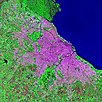Applications of Satellite Remote Sensing
Follow Us: Twitter Follow Us on Facebook YouTube Flickr | Share: Twitter Facebook|
1 of 3
Prev
|
Next
|
Anthropogenic Biomes of the World, v2 (1700)Anthropogenic BiomesTo provide information on anthropogenic transformation of the biosphere circa 1700 for global land use studies and research on human-environment interactions. |
Annual PM2.5 Concentrations for Countries and Urban Areas, v1 (
|
|
Anthropogenic Biomes of the World, v2 (1800)Anthropogenic BiomesTo provide information on anthropogenic transformation of the biosphere circa 1800 for global land use studies and research on human-environment interactions. |
Anthropogenic Biomes of the World, v2 (2000)Anthropogenic BiomesTo provide information on anthropogenic transformation of the biosphere circa 2000 for global land use studies and research on human-environment interactions. |
|
Global (GL) Annual PM2.5 Grids from MODIS, MISR and SeaWiFS Aerosol Optical Depth (AOD), v4.03 (
|
VIIRS Plus DMSP Change in Lights (VIIRS+DMSP dLIGHT), v1 (1992, 2002, 2013)Satellite-Derived Environmental Indicators |
|
Anthropogenic Biomes of the World, v2 (1900)Anthropogenic BiomesTo provide information on anthropogenic transformation of the biosphere circa 1900 for global land use studies and research on human-environment interactions. |
||
Global Urban Heat Island (UHI) Data Set, v1 (2013)Satellite-Derived Environmental Indicators |
||
Global Summer Land Surface Temperature (LST) Grids, v1 (2013)Satellite-Derived Environmental Indicators |
Global Human Modification of Terrestrial Systems, v1 (2016)Land Use and Land Cover |
|
Global Development Potential Indices, v1 (2016)Land Use and Land Cover |
Trends in Global Freshwater Availability from the Gravity Recovery and Climate Experiment (GRACE), v1 (
|
|
Urban Landsat: Cities from Space, v1 (
|
||
Annual Chlorophyll-a Concentration, v1 (
|
Change in Chlorophyll-a Concentration, v1 (
|
|
Ancillary Data, v1 (
|
Global Human Built-up And Settlement Extent (HBASE) Dataset From Landsat, v1 (2010)Global High Resolution Urban Data from Landsat |
|
1 of 3
Prev
|
Next
|












